小学英语语法入门(一)
- 格式:doc
- 大小:35.50 KB
- 文档页数:5
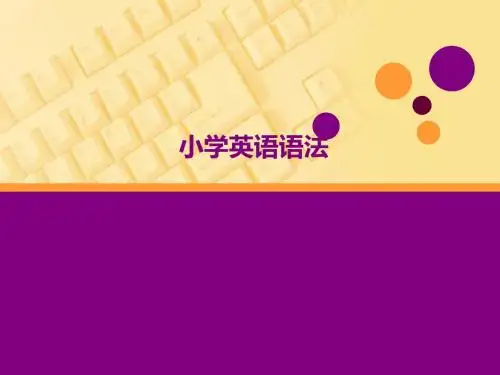
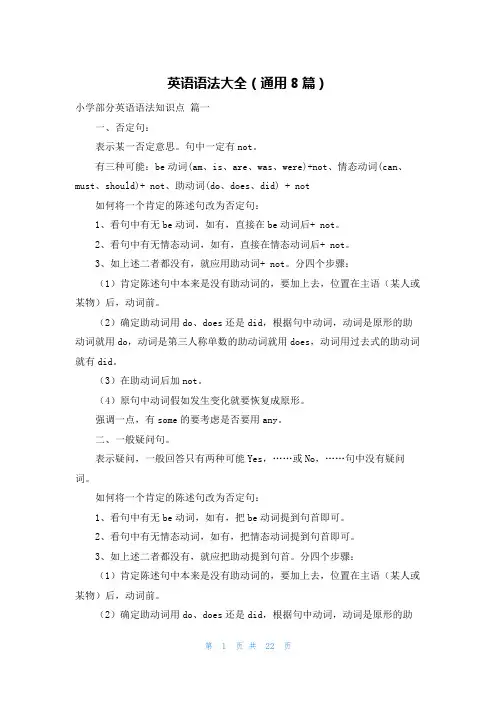
英语语法大全(通用8篇)小学部分英语语法知识点篇一一、否定句:表示某一否定意思。
句中一定有not。
有三种可能:be动词(am、is、are、was、were)+not、情态动词(can、must、should)+ not、助动词(do、does、did) + not如何将一个肯定的陈述句改为否定句:1、看句中有无be动词,如有,直接在be动词后+ not。
2、看句中有无情态动词,如有,直接在情态动词后+ not。
3、如上述二者都没有,就应用助动词+ not。
分四个步骤:(1)肯定陈述句中本来是没有助动词的,要加上去,位置在主语(某人或某物)后,动词前。
(2)确定助动词用do、does还是did,根据句中动词,动词是原形的助动词就用do,动词是第三人称单数的助动词就用does,动词用过去式的助动词就有did。
(3)在助动词后加not。
(4)原句中动词假如发生变化就要恢复成原形。
强调一点,有some的要考虑是否要用any。
二、一般疑问句。
表示疑问,一般回答只有两种可能Yes,……或No,……句中没有疑问词。
如何将一个肯定的陈述句改为否定句:1、看句中有无be动词,如有,把be动词提到句首即可。
2、看句中有无情态动词,如有,把情态动词提到句首即可。
3、如上述二者都没有,就应把助动提到句首。
分四个步骤:(1)肯定陈述句中本来是没有助动词的,要加上去,位置在主语(某人或某物)后,动词前。
(2)确定助动词用do、does还是did,根据句中动词,动词是原形的助动词就用do,动词是第三人称单数的助动词就用does,动词用过去式的助动词就有did。
(3)把助动词后提到句首。
(4)原句中动词假如发生变化就要恢复成原形。
强调一点,有some的要考虑是否要用any。
三、特殊疑问句。
表示疑问,有疑问词(在开头),回答有很多种可能。
常用疑问词:What、When、Which、Who、Whose、Why、How如何对划线部分提问:1、将原问句翻译为汉语(在读中要将划线部分重读)。
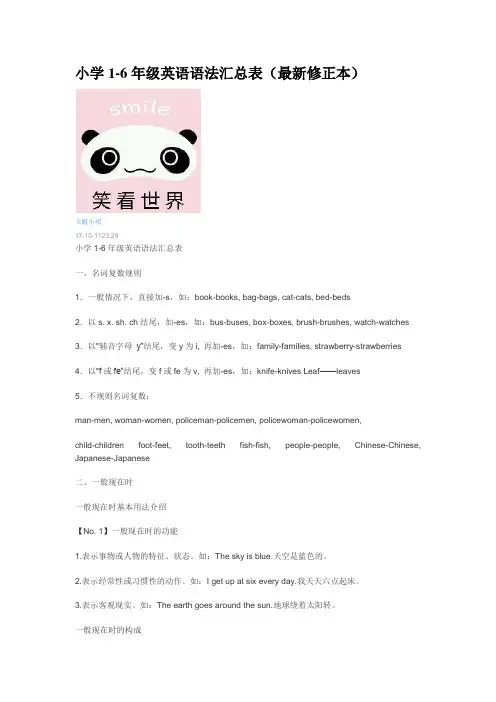
小学1-6年级英语语法汇总表(最新修正本)大眼小状17-10-1123:29小学1-6年级英语语法汇总表一、名词复数规则1.一般情况下,直接加-s,如:book-books, bag-bags, cat-cats, bed-beds2.以s. x. sh. ch结尾,加-es,如:bus-buses, box-boxes, brush-brushes, watch-watches3.以“辅音字母y”结尾,变y为i, 再加-es,如:family-families, strawberry-strawberries4.以“f或fe”结尾,变f或fe为v, 再加-es,如:knife-knives Leaf——leaves5.不规则名词复数:man-men, woman-women, policeman-policemen, policewoman-policewomen,child-children foot-feet, tooth-teeth fish-fish, people-people, Chinese-Chinese, Japanese-Japanese二、一般现在时一般现在时基本用法介绍【No. 1】一般现在时的功能1.表示事物或人物的特征、状态。
如:The sky is blue.天空是蓝色的。
2.表示经常性或习惯性的动作。
如:I get up at six every day.我天天六点起床。
3.表示客观现实。
如:The earth goes around the sun.地球绕着太阳转。
一般现在时的构成1. be动词:主语be(am,is,are) 其它。
如:I am a boy.我是一个男孩。
2.行为动词:主语行为动词( 其它)。
如:We study English.我们学习英语。
当主语为第三人称单数(he, she,it)时,要在动词后加"-s"或"-es"。
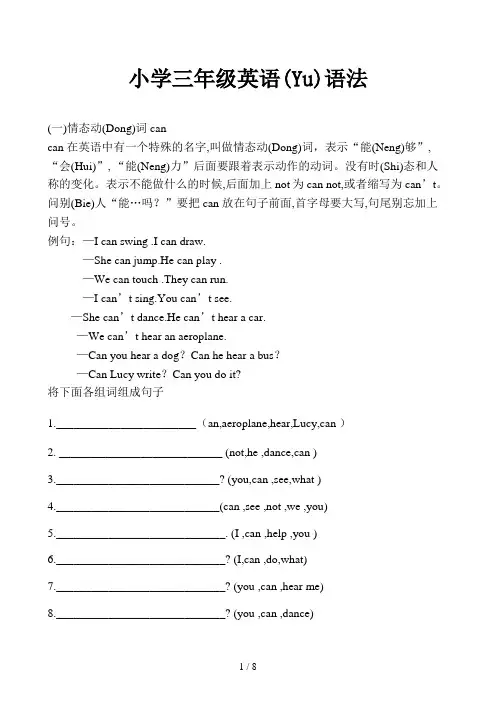
小学三年级英语(Yu)语法(一)情态动(Dong)词cancan 在英语中有一个特殊的名字,叫做情态动(Dong)词,表示“能(Neng)够”, “会(Hui)”, “能(Neng)力”后面要跟着表示动作的动词。
没有时(Shi)态和人称的变化。
表示不能做什么的时候,后面加上 not为 can not,或者缩写为can’t。
问别(Bie)人“能…吗?”要把can 放在句子前面,首字母要大写,句尾别忘加上问号。
例句:—I can swing .I can draw.—She can jump.He can play .—We can touch .They can run.—I can’t sing.You can’t see.—She can’t dance.He can’t hear a car.—We can’t hear an aeroplane.—Can you hear a dog?Can he hear a bus?—Can Lucy write?Can you do it?将下面各组词组成句子1.________________________(an,aeroplane,hear,Lucy,can )2. ____________________________ (not,he ,dance,can )3.____________________________? (you,can ,see,what )4.____________________________(can ,see ,not ,we ,you)5._____________________________. (I ,can ,help ,you )6._____________________________? (I,can ,do,what)7._____________________________? (you ,can ,hear me)8._____________________________? (you ,can ,dance)答(Da)案:1. Lucy can hear an aeroplane. 2. He can not /can’t dance.3. What can you see?4. We can not /can’t see you5. I can help you.6. What can I do?7. Can you hear me? 8. Can you dance?(二(Er))人称代词所属格. 人(Ren)称代词表等。
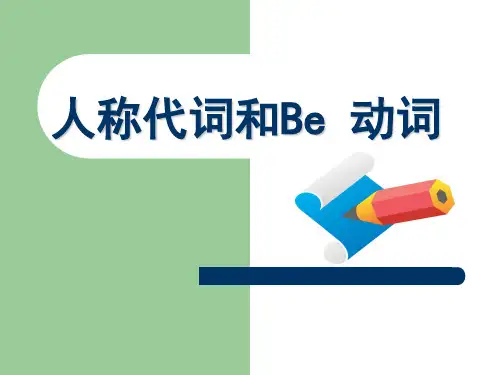
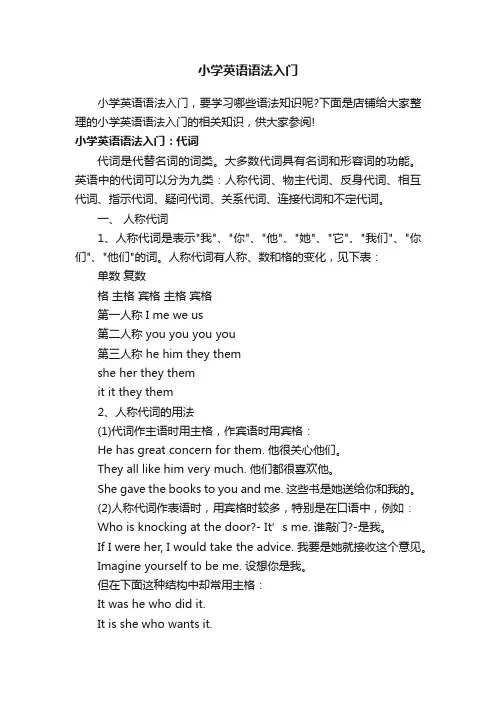
小学英语语法入门小学英语语法入门,要学习哪些语法知识呢?下面是店铺给大家整理的小学英语语法入门的相关知识,供大家参阅!小学英语语法入门:代词代词是代替名词的词类。
大多数代词具有名词和形容词的功能。
英语中的代词可以分为九类:人称代词、物主代词、反身代词、相互代词、指示代词、疑问代词、关系代词、连接代词和不定代词。
一、人称代词1、人称代词是表示"我"、"你"、"他"、"她"、"它"、"我们"、"你们"、"他们"的词。
人称代词有人称、数和格的变化,见下表:单数复数格主格宾格主格宾格第一人称 I me we us第二人称 you you you you第三人称 he him they themshe her they themit it they them2、人称代词的用法(1)代词作主语时用主格,作宾语时用宾格:He has great concern for them. 他很关心他们。
They all like him very much. 他们都很喜欢他。
She gave the books to you and me. 这些书是她送给你和我的。
(2)人称代词作表语时,用宾格时较多,特别是在口语中,例如:Who is knocking at the door?- It’s me. 谁敲门?-是我。
If I were her, I would take the advice. 我要是她就接收这个意见。
Imagine yourself to be me. 设想你是我。
但在下面这种结构中却常用主格:It was he who did it.It is she who wants it.在表示比较的非正式的文体中,常用宾格代替主格:He is more intelligent than her.He is taller than I am.3、在使用人称代词时还应注意以下几点:(1)we, you两词有时可用来泛指一般人:We (you) have to be cautious under such circumstances.在这样的情况下大家应特别小心。
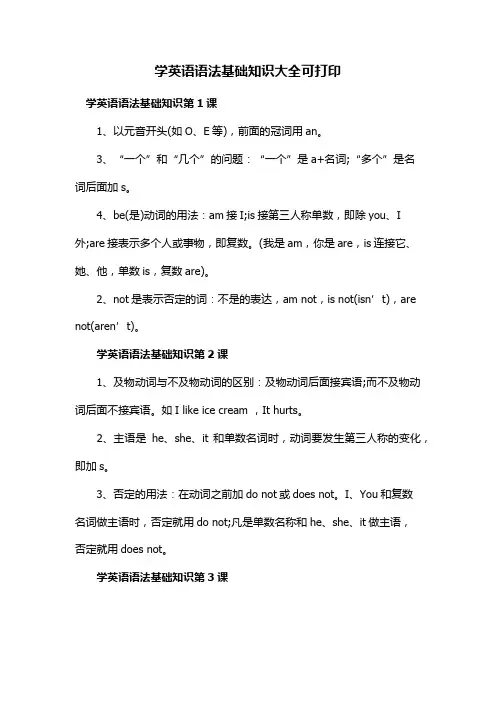
学英语语法基础知识大全可打印学英语语法基础知识第1课1、以元音开头(如O、E等),前面的冠词用an。
3、“一个”和“几个”的问题:“一个”是a+名词;“多个”是名词后面加s。
4、be(是)动词的用法:am接I;is接第三人称单数,即除you、I外;are接表示多个人或事物,即复数。
(我是am,你是are,is连接它、她、他,单数is,复数are)。
2、not是表示否定的词:不是的表达,am not,is not(isn’t),are not(aren’t)。
学英语语法基础知识第2课1、及物动词与不及物动词的区别:及物动词后面接宾语;而不及物动词后面不接宾语。
如I like ice cream ,It hurts。
2、主语是he、she、it和单数名词时,动词要发生第三人称的变化,即加s。
3、否定的用法:在动词之前加do not或does not。
I、You和复数名词做主语时,否定就用do not;凡是单数名称和he、she、it做主语,否定就用does not。
学英语语法基础知识第3课1、用名词+of+名词,一般用在无生命的名词上,表示“……的’’,如The sound of music(音乐之声)。
2、名词所有格形式为:名词+’s,表示“……的”,如Sophie’s world,children’s Day,Japan’s tomorrow。
3、my(我的)、your(你的)、his(他的)、her(她的)、their(他们的)、our(我们的)、its(它的)+名词,如my love,your love 。
学英语语法基础知识第4课1、“have”和“there be”翻译成汉语都可以用一个“有”字来表示,但have是指主观的“所有、拥有”,而there be则是指客观的“存在,某处有某物”。
2、There be的单复数变化与be的变化规则相同,取决于后面所接的主语。
主语为单数,就变成there is,主语是复数,就变成there are。

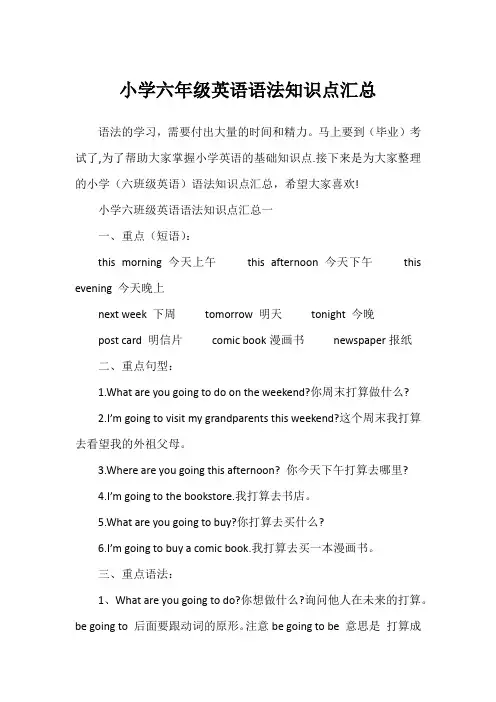
小学六年级英语语法知识点汇总语法的学习,需要付出大量的时间和精力。
马上要到(毕业)考试了,为了帮助大家掌握小学英语的基础知识点.接下来是为大家整理的小学(六班级英语)语法知识点汇总,希望大家喜欢!小学六班级英语语法知识点汇总一一、重点(短语):this morning 今天上午this afternoon 今天下午this evening 今天晚上next week 下周tomorrow 明天tonight 今晚post card 明信片comic book漫画书newspaper报纸二、重点句型:1.What are you going to do on the weekend?你周末打算做什么?2.I’m going to visit my grandparents this weekend?这个周末我打算去看望我的外祖父母。
3.Where are you going this afternoon? 你今天下午打算去哪里?4.I’m going to the bookstore.我打算去书店。
5.What are you going to buy?你打算去买什么?6.I’m going to buy a comic book.我打算去买一本漫画书。
三、重点语法:1、What are you going to do?你想做什么?询问他人在未来的打算。
be going to 后面要跟动词的原形。
注意be going to be 意思是打算成为什么,干什么职业。
注意一下(句子)的区别,找出正确回答。
What are you going to do this afternoon?What are you going to buy?What are you going to be?When? are you going?Where are you going?How are you going?Who are you going with?2、this evening 和tonight的区别:this evening指的是今天晚上睡觉以前的时间,一般指晚上十二点以前。
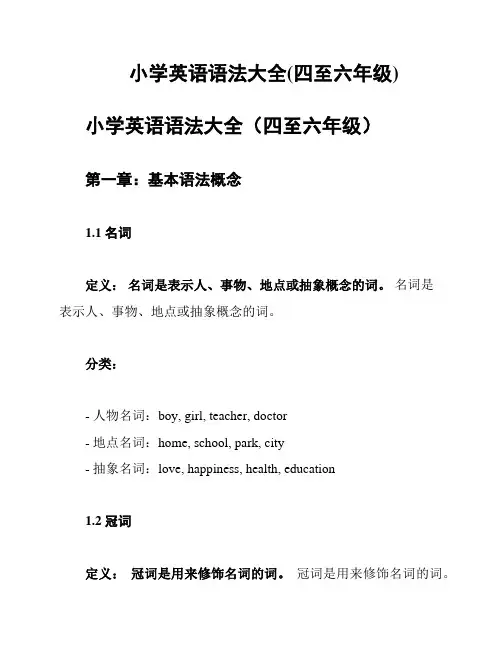
小学英语语法大全(四至六年级)小学英语语法大全(四至六年级)第一章:基本语法概念1.1 名词定义:名词是表示人、事物、地点或抽象概念的词。
名词是表示人、事物、地点或抽象概念的词。
分类:- 人物名词:boy, girl, teacher, doctor- 地点名词:home, school, park, city- 抽象名词:love, happiness, health, education1.2 冠词定义:冠词是用来修饰名词的词。
冠词是用来修饰名词的词。
分类:- 不定冠词:a, an- 定冠词:the1.3 代词定义:代词是用来代替名词的词。
代词是用来代替名词的词。
分类:- 人称代词:I, you, he, she, it, we, they- 物主代词:my, your, his, her, its, our, their- 反身代词:myself, yourself, himself等1.4 形容词和副词定义:- 形容词:用来修饰名词的词。
- 副词:用来修饰动词、形容词或其他副词的词。
比较级和最高级:- 比较级:表示两个事物之间的比较。
如:bigger, smaller- 最高级:表示多个事物中的最高或最低。
如:biggest, smallest 第二章:动词2.1 动词的分类- 行为动词:run, jump, read, write- 状态动词:be, have, exist- 助动词:do, does, did, can, may, shall, will2.2 动词的时态- 现在时:表示现在或经常发生的事。
如:I read a book.- 过去时:表示过去发生的事。
如:I read a book yesterday.- 将来时:表示将来会发生的的事。
如:I will read a book tomorrow.第三章:句子结构3.1 简单句简单句是由一个主语和一个谓语构成的句子。
如:The cat sleeps.3.2 复合句复合句是由两个或两个以上的简单句合并而成的句子。
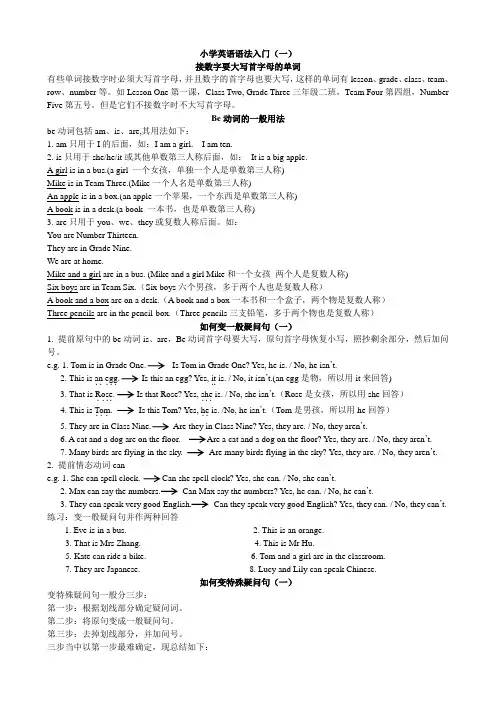
小学英语语法入门(一)接数字要大写首字母的单词有些单词接数字时必须大写首字母,并且数字的首字母也要大写,这样的单词有lesson、grade、class、team、row、number等。
如Lesson One第一课,Class Two, Grade Three三年级二班,Team Four第四组,Number Five第五号。
但是它们不接数字时不大写首字母。
Be动词的一般用法be动词包括am、is、are,其用法如下:1. am只用于I的后面,如:I am a girl. I am ten.2. is只用于she/he/it或其他单数第三人称后面,如:It is a big apple.A girl is in a bus.(a girl 一个女孩,单独一个人是单数第三人称)Mike is in Team Three.(Mike一个人名是单数第三人称)An apple is in a box.(an apple一个苹果,一个东西是单数第三人称)A book is in a desk.(a book 一本书,也是单数第三人称)3. are只用于you、we、they或复数人称后面。
如:You are Number Thirteen.They are in Grade Nine.We are at home.Mike and a girl are in a bus. (Mike and a girl Mike和一个女孩两个人是复数人称)Six boys are in Team Six.(Six boys六个男孩,多于两个人也是复数人称)A book and a box are on a desk.(A book and a box一本书和一个盒子,两个物是复数人称)Three pencils are in the pencil-box.(Three pencils三支铅笔,多于两个物也是复数人称)如何变一般疑问句(一)1. 提前原句中的be动词is、are,Be动词首字母要大写,原句首字母恢复小写,照抄剩余部分,然后加问号。
第一部分:基础知识1.字母:26个字母的大小写ABCDEFGHIJKLMNOPQRSTUVWXYZabcdefghijklmnopqrstuvwxyz2.语音:元音的发音五个元音字母:A E I O U12个单元音:前元音:[i:] [ɪ] /e/ [æ]中元音:[ɜ:] [ə]后元音:[ɑ:][ʌ] [ɔ:][ɒ] [u :] [ʊ]双元音(8个)Ⅰ.合口双元音(5个)[ai] [ei] [au] [əu] [ɔi]Ⅱ.集中双元音(3个) [iə] [εə] [uə]3.词汇:词汇量,近反义词4.句子:大小写,标点符号第二部分:语法知识一.名词:名词单复数,名词的格(一)名词单复数1.一般情况,直接加-s,如:book-books, bag-bags, cat-cats, bed-beds2.以s. x. sh. ch结尾,加-es,如:bus-buses, box-boxes, brush-brushes, watch-watches3.以“辅音字母+y”结尾,变y为i, 再加-es,如:family-families, strawberry-strawberries4.以“f或fe”结尾,变f或fe为v, 再加-es,如:knife-knives5.不规则名词复数:(需背熟)man-men, woman-women, policeman-policemen, policewoman-policewomen, mouse-micechild-children, foot-feet, tooth-teeth, fish-fish, people-people, Chinese-Chinese, Japanese-Japanese不可数名词的复数就是原型: paper, juice, water, milk, rice, tea(二)名词的格(1) 有生命的东西的名词所有格:a) 单数后加’s 如: Lucy’s ruler my father’s shirtb) 以s 结尾的复数名词后加’如: his friends’ bagsc) 不以s 结尾的复数后加’s children’s shoesl并列名词中,如果把’s加在最后一个名词后,表示共有, 如:Tom and Mike’s car 汤姆和迈克共有的小汽车l要表示所有物不是共有的,应分别在并列名词后加’sTom’s and Mike’s cars 汤姆和麦克各自的小汽车(2)表示无生命东西的名词通常用“ of +名词”来表示所有关系:如:a picture of the classroom a map of China第二部分:语法知识二.冠词:不定冠词,定冠词种类:(1)不定冠词:a / an a unit / an uncle元音开头的可数名词前用an :an egg / an apple / an orange / an eraser / an answer / an ID card / an alarm clock / an actor / an actress / an e-mail / an address / an event / an example / an opera / an houran old man / an interesting book / an exciting sport / an action movie / an art lesson /(2)定冠词:the the egg the plane2. 用法:定冠词的用法:(1)特指某(些)人或某(些)物: The ruler is on the desk.(2)复述上文提到的人或物:He has a sweater. The sweater is new.(3)谈话双方都知道的人或物:The boys aren’t at school.(4)在序数词前:John’s birthday is February the second.(5)用于固定词组中: in the morning / afternoon / evening不用冠词的情况:(1)专有名词前:China is a big country.(2)名词前有定语:this , that , my , your , some, any , no 等:This is my baseball.(3)复数名词表示一类人和事:Monkeys can’t swim. They are teachers.(4)在节日,日期,月份,季节前:Today is Christmas Day. It’s Sunday.(5)一日三餐前:We have breakfast at 6:30.(6)球类棋类运动前:They often play football after class. He plays chess at home.* 但乐器前要用定冠词:I play the guitar very well.(7)学科名称前:My favorite subject is music.(8)在称呼或头衔的名词前:This is Mr Li.(9)固定词组中:at noon at night by bus第二部分:语法知识三、代词:人称代词、物主代词、反身代词形容词,副词:比较级,最高级(一)、形容词的比较级1、形容词比较级在句子中的运用:两个事物或人的比较用比较级,比较级后面一般带有单词than。
(完整版)小学英语语法总结全集小学英语语法总结全集小学英语语法汇总(一)可数名词与别可数名词“分家”一、可数名词与别可数名词的区不一般名词所表示的人或事物是能够按个数计算的,这类名词叫可数名词。
可数名词分为个体名词(表示某类人或事物中的个体,如worker, farmer, desk, fact ory等)和集体名词(表示作为一具整体来看的一群人或一些事物,如people,fa mily 等)。
假如一般名词所表示的事物是别能按个数来计算的,这类名词就叫别可数名词。
别可数名词分为物质名词(表示无法分为个体的物质,如meat, rice, water, milk, orange 等)和抽象名词(表示动作、状态、事情、品质等抽象概念,如work, homework, time, health, friendship等)。
二、可数名词的家务事可数名词有单数和复数两种形式。
指一具人或一件事物时,用单数形式;指两个或多个人或事物时用复数形式。
名词由单数形式变成复数形式的规则如下: 1. 普通的名词词尾直截了当加-s 。
如:book → books room → roomshouse → houses day → days2. 以s,ss, ch,sh, x 结尾的名词,在词尾加-es 。
如:bus → buses glass → glasseswatch → watchesdish → dishes box → boxes3. 以"辅音字母+y"结尾的名词,要先将y改为i再加-es。
如:city → cities body → bodiesfactory → factories等等。
4. 以f 或fe 结尾的名词,要将f或fe改为v再加-es。
如:half → halves leaf → leavesknife → knives wife → wives5. 特例[悄悄话:特例常常考,要记住。
小学英语语法大全第一章名词一、定义名词是表示人或事物名称的词。
它既可以表示具体的东西,也可以是表示抽象的东西。
二、分类1. 名词可以根据意义分为普通名词和专有名词如:john is a studentstudent是普通名词,john是专有名词普通名词前可以用不定冠词a/an, 定冠词the 或不加冠词,专有名词前一般不加冠词,专有名词的首字母要大写。
2. 普通名词又可以分为个体名词、集体名词、物质名词和抽象名词,其中个体名词与集体名词是可数名词,物质名词和抽象名称是不可数名词。
3. 专有名词专有名词是表示人名、地名、团体、机构、组织等的专有名词,多为独一无二的事物。
三、名词的数1、名词分为可数名词和不可数名词。
可数名词——可以数的名词不可数名词——数不清(没有复数)drink?milk tea water orange juice coke coffee porridgefood?rice bread meat fish fruit cake dumplings2、可数名词与不定冠词a(an)连用有数数形式,不可数名词不能与不定冠词a(an)连用,没有复数形式many+可数名词复数much/a little+不可数名词some, any , a lot of (lots of) 两者都可以修饰。
3、可数名词可以直接用数词来修饰不可数名词数词 +量词 +of + 名词对可数名词的数量提问用how many对不可数名词的数量提问用 how much4、不可数名词的量有以下两种表示方法:1) some, much ,a little ,a lot of ,a bit of , plenty of 用等表示多少。
注意既可以与可数名词复数,又可以与不可数名词连用的有:plenty of ,some ,a lot of ,lots of ,most of 等。
如there is much water in the bottle .瓶中有很多水。
小学英语语法一本全第一章名词1.名词的数2.名词的格第二章代词1.人称代词2.物主代词第三章冠词与数词1.冠词2.数词第四章一般现在时态第五章现在进行时态第六章句型1.陈述句2.疑问句3.祈使句4.There be 句型与have\ has第七章总结考试名词的概念在生活中,我们会接触到各种各样的人和事物,用来表示这些人或事物名称的词就是名词。
一、名词的数名词的数指名词的单数和复数形式。
可数名词表示“一个”时用单数,“两个以上”时用复数;不可数名词表示量时,通常用“数词+单位+of+物质名词”的形式,如 a piece of bread (一片面包),变为复数时,只须将单位名词变为复数,如:two pieces of bread(两片面包)。
*名词复数的构成法则1. 一般情况下在词尾加 s. 词尾读音shop --- shops (商店) 在清辅音后读[ s ]bag --- bags (书包) 在浊辅音后读[ z ]window --- windows (窗户) 在元音后读[ z ]2. 以s, x, sh, ch 结尾的单词在词尾加es。
class --- classes (班级) 词尾读音[ iz ]box --- boxes (盒子)match --- matches (比赛)brush --- brushes (刷子)3. 以“辅音字母+y”结尾的词,变y为i 加es.story --- stories (故事) 词尾读音[ iz ]4. 以“元音字母+y”结尾的词,在词尾直接加skey --- keys 词尾读音[ z ]monkey --- monkeys5.以“o” 结尾的名词,复数一般在词尾加“s”, 但个别加“es”tomato --- tomatoes (西红柿) 词尾读音[ z ]potato --- potatoes (土豆)zoo --- zoos (动物园)photo --- photos (照片)*(以“o”结尾,复数加“es”)口诀:黑人(Negro)英雄(hero),左手拿着西红柿(tomato),右手拿着破土豆(potato),头顶一个大芒果(mango)。
1:“first”是序数词,与“the”相连,解释为第一。
2:像“first,term,world”作为词组出现时前面要加“the”。
3:“all”所有;后面的可数名词用复数形式,be动词用“are”。
4:“any”一些;用在否定句和一般疑问句中,与“some”同义。
“some”用在肯定句中。
5:there be+数词,采用“就近原则”。
6:a map of China 与 a map of the world 要牢记。
7:要用“on the wall”,不能用“in the wall”。
门、窗在墙上才能用“in the wall”。
8:can 后+动词原形。
9:play+the+乐器; play+球类;10:like的用法11:动词变动名词形式方法:A--直接在动词后面+ing形式(大多数)。
B--以不发音的“e”结尾的,要去掉e后再+ing,比如:dancing,making,riding。
C--重读be音节,末尾只有一个辅音,须双写末尾的字母后再+ing,如:running,swimmi ng,sitting,putting。
12:现在进行时的构成:be动词+动词ing形式。
标志:now、look、listen、its time to。
13:现在进行时的一般疑问句 /问--be动词+人称+时态(动词ing)答--Yes,he/She/it is/am/are. No,he/She/it isnt/arent/am not.14:用Are you...? Yes,I am/ we are. No,Im not/We arent.15: 动词后+人称宾格形式.16:一般现在时的构成:第三人称单数(三单)。
要注意:后面的动词+s或es。
特例:have→has do→dose go→goes; 标志:often,usually。
17:有些名词变动词时要变形式,例如:teacher→teach;driver→drive.1.一般现在时一般现在时态中,动词一般用原形。
小学英语语法大全(完整版)小学英语语法大全第一章:名词一、定义名词是用来表示人或事物名称的词语。
它可以表示具体的事物,也可以表示抽象的概念。
二、分类1.名词可以根据意义分为普通名词和专有名词。
例如,john是一个学生,其中student是普通名词,而john是专有名词。
普通名词前可以用不定冠词a/an,定冠词the或不加冠词,而专有名词前一般不加冠词。
另外,专有名词的首字母要大写。
2.普通名词又可以分为个体名词、集体名词、物质名词和抽象名词。
其中,个体名词和集体名词是可数名词,而物质名词和抽象名词是不可数名词。
3.专有名词专有名词是用来表示人名、地名、团体、机构、组织等的专有名词,多数情况下是独一无二的。
三、名词的数1、名词可以分为可数名词和不可数名词。
可数名词——可以数的名词不可数名词——数不清(没有复数形式)例如:drink(饮料)、milk(牛奶)、tea(茶)、water (水)、orange juice(橙汁)、coke(可乐)、coffee(咖啡)、porridge(粥)、food(食物)、rice(米饭)、bread(面包)、meat(肉类)、fish(鱼)、fruit(水果)、cake (蛋糕)、dumplings(饺子)2、可数名词可以与不定冠词a/an连用,有复数形式。
而不可数名词不能与不定冠词连用,也没有复数形式。
在修饰可数名词时,可以直接使用数词。
而在修饰不可数名词时,需要使用量词。
例如:many+可数名词复数;不可数名词用much/alittle+some/any/a lot of3、不可数名词的数量可以用以下两种方式表示:第一种方式是使用等量词,例如:some、much、a little、a lot of、a bit of、plenty of等。
注意,有些词既可以与可数名词复数连用,也可以与不可数名词连用,例如:plenty of、some、a lot of、lots of、等等。
小学英语语法入门(一)接数字要大写首字母的单词有些单词接数字时必须大写首字母,并且数字的首字母也要大写,这样的单词有lesson、grade、class、team、row、number等。
如Lesson One第一课,Class Two, Grade Three三年级二班,Team Four第四组,Number Five第五号。
但是它们不接数字时不大写首字母。
Be动词的一般用法be动词包括am、is、are,其用法如下:1. am只用于I的后面,如:I am a girl. I am ten.2. is只用于she/he/it或其他单数第三人称后面,如: It is a big apple.A girl is in a bus.(a girl 一个女孩,单独一个人是单数第三人称)Mike is in Team Three.(Mike一个人名是单数第三人称)An apple is in a box.(an apple一个苹果,一个东西是单数第三人称)A book is in a desk.(a book 一本书,也是单数第三人称)3. are只用于you、we、they或复数人称后面。
如:You are Number Thirteen.They are in Grade Nine.We are at home.Mike and a girl are in a bus. (Mike and a girl Mike和一个女孩两个人是复数人称)Six boys are in Team Six.(Six boys六个男孩,多于两个人也是复数人称)A book and a box are on a desk.(A book and a box一本书和一个盒子,两个物是复数人称)Three pencils are in the pencil-box.(Three pencils三支铅笔,多于两个物也是复数人称)如何变一般疑问句(一)1. 提前原句中的be动词is、are,Be动词首字母要大写,原句首字母恢复小写,照抄剩余部分,然后加问号。
e.g. 1. Tom is in Grade One. Is Tom in Grade One? Yes, he is. / No, he isn’t.2. This is an egg. Is this an egg? Yes, it is. / No, it isn’t.(an egg是物,所以用it来回答)3. That is Rose. Is that Rose? Yes, she is. / No, she isn’t.(Rose是女孩,所以用she回答)4. This is Tom. Is this Tom? Yes, he is. /No, he isn’t.(Tom 是男孩,所以用he回答)5. They are in Class Nine. Are they in Class Nine? Yes, they are. / No, they aren’t.6. A cat and a dog are on the floor. Are a cat and a dog on the floor? Yes, they are. / No, they aren’t.7. Many birds are flying in the sky. Are many birds flying in the sky? Yes, they are. / No, the y aren’t.2. 提前情态动词cane.g. 1. She can spell clock. Can she spell clock? Yes, she can. / No, she can’t.2. Max can say the numbers. Can Max say the numbers? Yes, he can. / No, he can’t.3. They can speak very good English. Can they speak very good English? Yes, they can. / No, they can’t.练习:变一般疑问句并作两种回答1. Eve is in a bus.2. This is an orange.3. That is Mrs Zhang.4. This is Mr Hu.5. Kate can ride a bike.6. Tom and a girl are in the classroom.7. They are Japanese. 8. Lucy and Lily can speak Chinese.如何变特殊疑问句(一)变特殊疑问句一般分三步:第一步:根据划线部分确定疑问词。
第二步:将原句变成一般疑问句。
第三步:去掉划线部分,并加问号。
三步当中以第一步最难确定,现总结如下:1. 对姓名提问用Whate.g. 1. His name is Max. Wh at’s / What is his name?2. Her name is Rose. What’s / What is her name?2. 对物提问用Whate.g. 1. It is a banana. What’s /What is it?2. This is a pear. What’s / What is this?3. That is a chick. What’s / What is that?3. 对年级提问用What gradee.g. 1. Tom is in Grade Six. What grade is Tom in?2. She is in Grade Nine. What grade is she in?练习:变特殊疑问句1. That is a bag.2. His name is Sam.3. This is a blackboard.4. Amy is in Grade Eight.5. He is in Grade Seven.如何变一般疑问句(二)变一般疑问句,所涉及的所有第一人称都要改成第二人称(特殊除外)。
即:I(me) you,we(us) you, am are, my your, mine yours.e.g. 1. I am Number Six. Are you Number Six? Yes, I am. / No, I’m not.2. We are in Team Four. Are you in Team Four? Yes, we are. / No, we aren’t.3. This is my classroom. Is this your classroom? Yes, it is. / No, it isn’t.练习:变一般疑问句1. We are in the same grade.2. I am in Class Six.3. That is my sister.如何变特殊疑问句(二)1. 对班级提问用What classe.g. 1. Tom is in Class One, Grade Two. What class is Tom in?2. I am in Class Six, Grade Three. What class are you in?3. We are in Class Four, Grade Six. What class are you in?2. 对组、队提问用What teame.g. 1. I am in Team Nine. What team are you in?2. We are in Team Ten. What team are you in?3. Lingling is in Team Eleven. What team is Lingling in?3. 对姓名提问用Whate.g. My name is Jack. What is your name?练习:变特殊疑问句1. Daming is in Team Twelve.2. I’m in Class Six, Grade Nine.3. We are in Team Five.4. My name is Ms Smart.选择疑问句选择疑问句是由一般疑问句+or+其他构成的供选择的句子。
e.g. 1. Is this a pen or a pencil? It’s a pen.2. Are you English or American? I’m an American.(注意:选择疑问句or前面的单词要读声调,or后面的要读降调。
选择疑问句不能用yes或no回答,只能在or前后选择。
)练习:将下列句子与所给成分合并为选择疑问句并适当回答1. Are you in Class One?(Class Two)2. Can you speak Chinese?(Japanese)3. Do you like playing basketball?(football)4. Would you like some milk?(some juice)5. Is he Tom?(Sam)如何变特殊疑问句(三)1.对人提问用Who(一句话中有单词name,划线的一定是人名,疑问词就要用What;如果没有单词name,则划线的一定是人。
)e.g. 1. She is Kate. Who is she?2. Her name is Kate. What is her name?3. This boy is Jim. Who is this boy?4. His name is Jim. What is his name?5. That woman is Ms Smart. Who is that woman?6. Her name is Ms Smart. What is her name?2.对年龄提问用How olde.g. 1. She is nine. How old is she?2. Eve is ten. How old is Eve?3.对排、行提问用What rowe.g. 1. Mike is in Row Nine. What row is Mike in?2. He is in Row Five. What row is he in?3. I’m in Row Four. What row are you in?4. 对地点提问用Wheree.g. 1. Mike is on the hill. Where is Mike?2. The cat is in the box. Where is the cat?3. A pear is on the chair. Where is the pear?(上句出现a,下句用the特指)练习:变特殊疑问句1. Coy is in a bus.2. Laura is in Row Five.3. Rose is twelve.4. The girl is Lucy.5. I am at school.6. That man is Mr Hu.7. I’m twenty. 8. A woman is in the room.9. Her name is Lucy. 10. I am Mr Wang.英语中的打电话英语中的打电话,通常是接电话者自报号码,如Hello, 89321204. 我是XXX,不说I’m …,而说This is …。